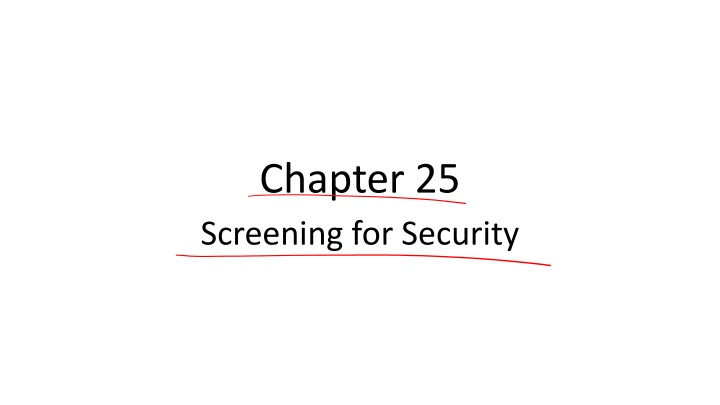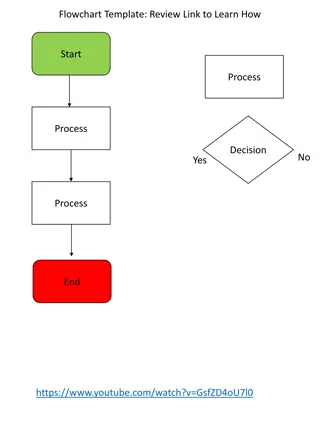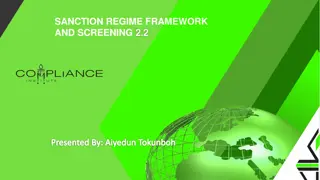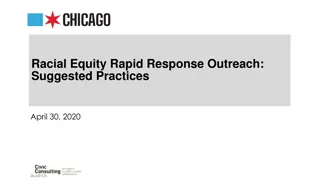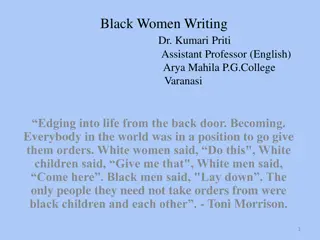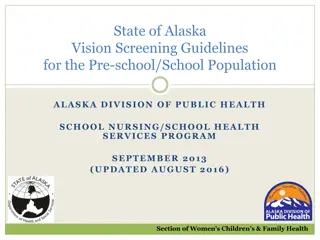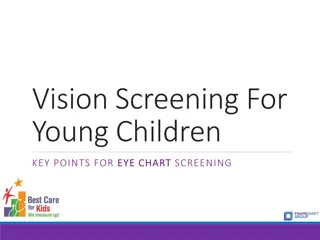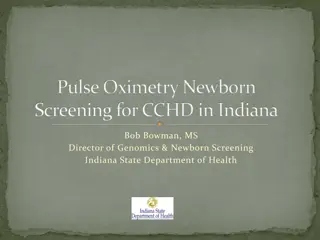Screening for Security: Black September Hijackings & Pre-9/11 Concerns
Before the events of 9/11, the focus was on preventing bomb threats while handling luggage without passengers. Learn about the Black September group and the impact of hijackings. Explore the United States v. Saboonchi case and the critical Border Search Doctrine in customs enforcement.
Download Presentation

Please find below an Image/Link to download the presentation.
The content on the website is provided AS IS for your information and personal use only. It may not be sold, licensed, or shared on other websites without obtaining consent from the author.If you encounter any issues during the download, it is possible that the publisher has removed the file from their server.
You are allowed to download the files provided on this website for personal or commercial use, subject to the condition that they are used lawfully. All files are the property of their respective owners.
The content on the website is provided AS IS for your information and personal use only. It may not be sold, licensed, or shared on other websites without obtaining consent from the author.
E N D
Presentation Transcript
Chapter 25 Screening for Security
Black September September 1970 Hijackings On Sept 6, 1970, a Palestinian terrorist group hijacked 4 airlines, and was hereinafter called the Black September Group, then the PLO. They hijacked a 5thplane a few days later. Three of the planes were flown to a desert site, where the passengers were held hostage for a few days. The hostages were released with only 1 death, but the planes were destroyed. The US 9/11 hijackings were inspired by Black September, and the timing was an homage to Black September. An after-incident report on Black September outlined several changes that should be made to prevent future hijackings, including reinforcing and locking the door between the cockpit and the cabin. These recommendations were not implemented. At least two novelists used a scenario of terrorists flying planes into a building before 9/11.
What Were We Worried About Before 9/11? Bombs This was mostly focused on keeping luggage without passengers out of planes It was not focused on suicide bombers, thus the luggage focus. How did this allow the 9/11 hijackings? Hijackers Before 9/11, there were three hijacking modes: Taking a plane to make a political statement Taking a plane for money (only worked once) Taking a plane to get to Cuba or another forbidden place While a few planes were lost, and there some fatalities when planes were recaptured, none had the objective of killing the passengers Policy was to cooperate with hijackers, not fight them. Passengers on one plane on 9/11 fought after the takeover and brought the plane down in a field. It was thought to have been headed to the White House.
United States v. Saboonchi, 990 F. Supp. 2d 536 (Dist MD 2014) Plaintiff is a dual United States-Iranian citizen who was reentering the country from a day trip in Canada. His name was on a watchlist and he was stopped and his smart phone and a USB drive were seized and searched. He was charged with violating export controls. This case arises from a motion to suppress evidence obtained without a proper warrant. 5
What is the Border Search Doctrine? Why is this critical to effective customs and border enforcement? Insofar as the touchstone of the Fourth Amendment is reasonableness, Florida v. Jimeno, 500 U.S. 248, 250 (1991) (citing Katz v. United States, 389 U.S. 347, 360 (1967)), it does not require Napoleonic insight to see how the power to conduct searches of this kind on a routine basis, without suspicion, is the sine qua non of customs and border enforcement; Thus no reasonable expectation of privacy when crossing the border.
How far from the border can you be? Extended border search depends on where you would reasonably encounter border officials. Where were the devices seized in this case? Baltimore airport after a direct flight from outside the US. This was legally outside the border because the search occurred before defendant cleared customs. He was technically crossing the border for the purpose of the search. Why is this the easiest case for a warrantless search?
What are the criteria for determining whether a suspicianless border search is reasonable? (i) whether the search results in the exposure of intimate body parts or requires the suspect to disrobe; (ii) whether physical contact between Customs officials and the suspect occurs during the search; (iii) whether force is used to effect the search; (iv) whether the type of search exposes the suspect to pain or danger; (v) the overall manner in which the search is conducted; and (vi) whether the suspect s reasonable expectations of privacy, if any, are abrogated by the search (United States v. Braks)
What is an Unreasonable Border Search Requiring Suspicion? a defendant suspected of smuggling drugs in her alimentary canal was told that she would not be released into the United States until she submitted to an x-ray or produced a monitored bowel movement that would confirm or rebut the inspectors suspicions. As a result, she was detained incommunicado for almost 16 hours before inspectors sought a warrant. In holding that the detention required, and in that particular case was justified by, reasonable suspicion, the Court expressly refrained from defining what level of suspicion, if any, is required for nonroutine border searches such as strip, body cavity, or involuntary x-ray searches, United States v. Montoya de Hernandez
What About Electronic Devices? These are 4th Amendment searches. TSA can require anyone to turn on a computer to show it is a real computer. Once routine, I have not see it done in years. At the border you must, if asked: Boot up your computer, log in, and allow the agent to look at, but not copy files. Gets complicated when they want to use your automatic logins for things outside the computer. Unlock your phone and allow it to be examined. If you do not cooperate, the devices can be seized Mail your device across the border?
What is a forensic search? In contrast, a forensic search is a different search not merely a search of a different object and it fundamentally alters the playing field for all involved. A forensic search requires the creation of a bitstream copy and its thorough analysis with specialized software over an extended period of time. 11
What is unique about a forensic search? First, because the item searched is a bitstream copy of a device, it may take place long after the device itself has been returned to its owner and therefore a forensic search is unbounded in time. Second, a forensic search allows officers to recover a wealth of information even after it has been deleted. And third, a forensic search provides information about a person s domestic activities away from the border that is not otherwise available even in a conventional search taking place at the border. The search in this case required reasonable suspicion, but the Court found that it was present. 12
Subsequent cases on forensic searches at the border We see no reason why the Fourth Amendment would require suspicion for a forensic search of an electronic device when it imposes no such requirement for a search of other personal property. it does not make sense to say that electronic devices should receive special treatment because so many people now own them or because they can store vast quantities of records or effects. The same could be said for a recreational vehicle filled with personal effects or a tractor-trailer loaded with boxes of documents. [United States v. Touset, 890 F.3d 1227, 1233 (11th Cir. 2018) 13
Riley v. California, 573 U.S. 373 (2014) (not border) [United States v. Robinson, 414 U.S. 218 (1973)] concluded that the two risks identified [incident to arrest] : : : harm to officers and destruction of evidence are present in all custodial arrests. There are no comparable risks when the search is of digital data. In addition, Robinson regarded any privacy interests retained by an individual after arrest as significantly diminished by the fact of the arrest itself. Cell phones, however, place vast quantities of personal information literally in the hands of individuals. A search of the information on a cell phone bears little resemblance to the type of brief physical search considered in Robinson. We therefore decline to extend Robinson to searches of data on cell phones, and hold instead that officers must generally secure a warrant before conducting such a search. [573 U.S. at 386.]
Alasaad v. Mayorkas, 988 F.3d 8 (1st Cir. 2021) As recently explained by this circuit, Riley d[id] not either create or suggest a categorical rule to the effect that the government must always secure a warrant before accessing the contents of [an electronic device]. United States v. Rivera-Morales, 961 F.3d 1, 14 (1st Cir. 2020). Nor does Riley by its own terms apply to border searches, which are entirely separate from the search incident to arrest searches discussed in Riley. The search incident to arrest warrant exception is premised on protecting officers and preventing evidence destruction, rather than on addressing border crime. A warrant requirement and the delays it would incur would hamstring the agencies efforts to prevent border-related crime and protect this country from national security threats
CBP Policy for Border Searches of Electronic Devices The directive authorizes CBP officers to conduct a basic search, without suspicion, of information stored on a traveler s electronic device and accessible through a device s operating system and applications. Officers are not authorized to access information that is stored remotely, presumably including data residing on the cloud. If they form a reasonable suspicion of activity that violates laws administered by the CBP or raises a national security concern, however, they may conduct an advanced search using external equipment to access, copy, and analyze the contents of a device. Examples of factors in deciding reasonable suspicion include the existence of a national security-related lookout in combination with other articulable factors as appropriate, or the presence of an individual on a government operated and government-vetted terrorist watch list. CBP officers are also expressly authorized to request passwords from travelers, and travelers are obligated to present their devices in a condition that allows inspection of the device and its contents. Id. 5.3.1. If a traveler refuses to provide a password or if contents are encrypted, officers may detain her device.
Only Contraband? Alasaad v. Mayorkas, 988 F.3d 8 (1st Cir. 2021) We thus agree with the holdings of the Ninth and Eleventh circuits that basic border searches are routine searches and need not be supported by reasonable suspicion. . . . As for advanced searches, we cannot reasonably conclude that the substantive limitations imposed by the Constitution on the border search exception prevent Congress from giving border agencies authority to search for information or items other than contraband. To the contrary, Montoya de Hernandez makes clear that the border search exception s purpose is not limited to interdicting contraband; it serves to bar entry to those who may bring anything harmful into this country and then gives as examples whether that be communicable diseases, narcotics, or explosives.
United States v. Cano, 934 F.3d 1002, 1018 (9th Cir. 2019) (cert denied 2021) (holding that while border searches need not be supported by reasonable suspicion, the border search exception is restricted in scope to searches for contraband ). Thus there is an unresolved circuit split on the contraband question under the directive that the court chose not to resolve at this time.
TSA Acceptable Identification Adult passengers 18 and over must show valid identification at the airport checkpoint in order to travel. Driver's licenses or other state photo identity cards issued by Department of Motor Vehicles (or equivalent) Beginning Oct. 1, 2021, if you plan to use your state- issued ID or license to fly within the U.S., make sure it is REAL ID compliant. If you are not sure if your ID complies with REAL ID, check with your state department of motor vehicles. U.S. passport U.S. passport card DHS trusted traveler cards (Global Entry, NEXUS, SENTRI, FAST) U.S. Department of Defense ID, including IDs issued to dependents Permanent resident card Border crossing card State-issued Enhanced Driver s License Federally recognized, tribal-issued photo ID HSPD-12 PIV card Foreign government-issued passport Canadian provincial driver's license or Indian and Northern Affairs Canada card Transportation worker identification credential U.S. Citizenship and Immigration Services Employment Authorization Card (I-766) U.S. Merchant Mariner Credential Veteran Health Identification Card (VHIC) In coordination with its DHS counterparts, TSA has identified acceptable alternate identification for use in special circumstances at the checkpoint.
Forgot or Lost Your ID? In the event you arrive at the airport without valid identification, because it is lost or at home, you may still be allowed to fly. The TSA officer may ask you to complete an identity verification process which includes collecting information such as your name, current address, and other personal information to confirm your identity. If your identity is confirmed, you will be allowed to enter the screening checkpoint. You will be subject to additional screening, to include a patdown and screening of carry-on property. You will not be allowed to enter the security checkpoint if your identity cannot be confirmed, you choose to not provide proper identification or you decline to cooperate with the identity verification process. TSA recommends that you arrive at least two hours in advance of your flight time.
The REAL ID ActA Step in the Direction of a National ID Card? The REAL ID Act forbids any federal agency, from accepting for any official purpose a state-issued driver s license or identification card unless it meets certain requirements. The identification must include the licensee s name, address, date of birth, gender, a digital photo, signature, anti-tampering security features, and [a] common machine- readable technology, with defined minimum data elements. Id. 202(b)(9), 119 Stat. at 312. REAL ID deadline has been pushed to May 7, 2025 because of COVID. Who knows if it will ever be required? 21
What does the Real ID act require the states to do? In addition, the state must insist on and verify certain identifying information and evidence of lawful status to issue such an identification. Finally, each state must provide electronic access to all other States to information contained in the motor vehicle database of the States, which must include, at a minimum, all data fields printed on drivers licenses and identification cards issued by the State. Is this a national ID? Why or why not? 22
Should identifying yourself require a national ID card? What are the potential legal issues for a required national identity card? Is the problem requiring the card or requiring the card to be shown? Don t we require a social security card? Would a national id number solve the watch list confusion problem? 23
Subway and Train Searches Why did NY do random container searches for transit riders rather than search everyone? What is the intent of random searches? Can you walk away? Does that undermine the effectiveness claim? Could NY do a contraband search, such as a border search on transit riders? 24
Watchlists 25
Terrorist Identities Datamart Environment (TIDE) the master repository for international terrorism data. TIDE includes information the US Government possesses related to the identities of individuals known or appropriately suspected to be or to have been involved in activities constituting, in preparation for, in aid of, or related to terrorism (with the exception of purely domestic terrorism information). As of February 2017, TIDE contained about 1.6 million people, of which US Persons (both citizens and lawful permanent residents) accounted for approximately 16,000.
Terrorist Watchlist and Screening
Ibrahim v. Department of Homeland Security 62 F. Supp. 3d 909 (2014) (Ibrahim II) 28
How accurate is the watchlist process, as of 2008? TSA maintains a list of approximately 30,000 individuals who are commonly confused with those on the No- Fly and Selectee Lists. One major air carrier reported that it encountered 9,000 erroneous terrorist watchlist matches every day during April 2008. 29
What did the government say about her status as a threat to national security? Government counsel has conceded at trial that Dr. Ibrahim is not a threat to our national security. She does not pose (and has not posed) REDACTED This the government admits and this order finds 30
How did she end up on the no-fly list? Agent Kelley misunderstood the directions on the form and erroneously nominated Dr. Ibrahim to the TSA s no-fly list REDACTED He did not intend to do so. This was a mistake, he admitted at trial. He intended to nominate her to the REDACTED He checked the wrong boxes, filling out the form exactly the opposite way from the instructions on the form. 31
Why is the mistake significant beyond the database the agent was updating? The government maintains a web of interlocking watchlists, all now centered on the Terrorist Screening Database ( TSDB ). This web and how they interlock are important to the relief sought and awarded herein. 32
Was she given notice when she was added to the list? When persons are placed on the no-fly list or any other watchlist, they receive no formal notice of such placement and may never learn of such placement until, if ever, they attempt to board a plane or do any other act covered by the watchlist. 33
Why did adding her to the no-fly list then cost her the visa, so she could not return to the US? The visa may be prudentially revoked, thereby making the individual ineligible to approach the borders of the United States. Within the Department of State, such a revocation is called prudential. Such a prudential revocation forces the alien to reapply for a new visa, so that a new evaluation of the applicant s eligibility and admissibility can be made. 34
Was plaintiff given a visa to attend the trial in this case? Trial in this action began on December 2 and ended on December 6. As of December 6, Dr. Ibrahim had not received a response to her visa application. At trial, however, government counsel stated verbally that the visa had been denied. 35
What is the three part Matthews test as quoted in this opinion? First, the private interest that will be affected by the official action; second, the risk of an erroneous deprivation of such interest through the procedures used, and the probable value, if any, of additional or substitute procedural safeguards; and finally, the Government s interest. 36
What are plaintiffs interests? With respect to Dr. Ibrahim, the private interests at stake in her 2005 deprivations were the right to travel, Kent v. Dulles, 357 U.S. 116, 125 (1958), and the right to be free from incarceration, Hamdi v. Rumsfeld, 542 U.S. 507, 529 (2004), and from the stigma and humiliation of a public denial of boarding and incarceration, Paul v. Davis, 424 U.S. 693, 701, 711 (1976), any one of which would be sufficient and all three of which apply on this record. 37
What is the governments interest? With respect to the government s interest, all would surely agree that our government must and should track terrorists who pose a threat to America not just to its air travel but to any aspect of our national security. Should it matter in the analysis that the government made a mistake in this case? Probably not that is what the Matthews analysis is all about see factor 3. 38
What is factor 3 in this case? The final Mathews factor is the risk of an erroneous deprivation through the procedures used and the probable value, if any, of additional or substitute procedural safeguards. 39
What did the court order as plaintiffs remedy? Significantly, therefore, our case involves a conceded, proven, undeniable, and serious error by the government not merely a risk of error. Consequently, this order holds that due process entitles Dr. Ibrahim to a correction in the government s records to prevent the 2004 error from further propagating through the various agency databases and from causing further injury to Dr. Ibrahim. 40
What databases do defendants have to correct? By this order, all defendants shall specifically and thoroughly query the databases maintained by them, such as the TSDB, TIDE, CLASS, KSTF, TECS, IBIS, TUSCAN, TACTICS, and the no-fly and selectee lists, and to remove all references to the designations made by the defective 2004 nomination form or, if left in place, to add a correction in the same paragraph that the designations were erroneous and should not be relied upon for any purpose. 41
Did the due process violations justify a pre-injury hearing? Put differently, until concrete, reviewable adverse action occurs against a nominee, the Executive Branch must be free to maintain its watchlists in secret, just as federal agents must be able to maintain in secret its investigations into organized crime, drug trafficking organizations, prostitution, child-pornography rings, and so forth. 42
What do plaintiffs have to show for stigma plus? Plaintiffs have not alleged any tangible harm to their personal or professional lives that is attributable to their association with the No-Fly List, and which would rise to the level of a Constitutional deprivation of a liberty right. Furthermore, Plaintiffs have not alleged any injury to a property interest as a result of the disclosure of allegedly stigmatizing statements. Plaintiffs have not plead[ed] any tangible harm that satisfies the plus prong. Therefore, Plaintiffs have failed to state a stigma-plus Fifth Amendment claim. 43
When is a target entitled to relief? Once concrete, reviewable adverse action is taken against a target, then there is and will be time enough to determine what post-deprivation process is due the individual affected. 44
What does the court say about the reasonable suspicion standard? In this connection, since the reasonable suspicion standard is an internal guideline used within the Executive Branch for watchlisting and not imposed by statute (or by specific judicial holding), the Executive Branch is free to modify its own standard as needed by exception, even if the exception is cloaked in state secrets. Any other rule requiring reviewability before concrete adverse action would be manifestly unworkable. 45
Did it order the system to be changed? No Did she get her visa? It is true, as the government asserts as part of its ripeness position, that she cannot fly to the United States without a visa, but she is entitled to try to solve one hurdle at a time and perhaps the day will come when all hurdles are cleared and she can fly back to our country 46
Is Judicial Review for Individuals a Cure for Errors for the No-Fly List? [T]he DHS TRIP process suffers from an even more fundamental deficiency. As noted, the reasonable suspicion standard used to accept nominations to the TSDB is a low evidentiary threshold. This low standard is particularly significant in light of Defendants refusal to reveal whether travelers who have been denied boarding and who submit DHS TRIP inquiries are on the No-Fly List and, if they are on the List, to provide the travelers with reasons for their inclusion on the List. Without knowledge of a charge, even simple factual errors may go uncorrected despite potentially easy, ready, and persuasive explanations. Al Haramain Islamic Found., Inc. v. United States Dep t of Treasury, 686 F.3d 965, 982 (9th Cir. 2012).
What about US Citizens on Watch Lists? (N3 771) As applied to U.S. citizens, a federal court ruled in 2019 that the standard for inclusion in the database was too vague: [T]he risk of erroneous deprivation of plaintiffs travel-related and reputational liberty interests is high, and the currently existing procedural safeguards are not sufficient to address that risk. Elhady v. Kable, 391 F. Supp. 3d 562, 582 (E.D. Va. 2019). Elhady was reversed on appeal. Elhady v. Kable, 993 F.3d 208 (4th Cir. 2021). Although the court therefore did not need to conduct a due process balancing of interests, it expressed serious doubt in dicta that such balancing would favor the plaintiffs in light of the strong federal security interest and the comparatively weak weight of the private interests.
Mission Creep Watchlists are already used to control visa eligibility, entry, and departure; to screen airline passengers; to screen employees for sensitive jobs; and to trigger surveillance. Mission creep using lists for more and more purposes, including ordinary criminal and regulatory purposes, such as denial of firearms purchases is a continuing risk. Moreover, the court agreed with the Tenth Circuit that the government s act of including names in the TSDB does not mandate that private entities deny people such [employment] privileges. It merely makes information available to private entities, like companies handling nuclear power, and then those companies make their own choices. [It found that plaintiffs had not shown that disclosure to employers had led to any employment-related injury.] By their nature, terrorist lists depend on profiling, which is discussed in Chapter 26. 49
